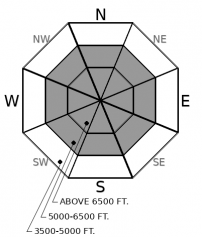| Friday | Friday Night | Saturday | |
|---|---|---|---|
| Cloud Cover: | Mostly Cloudy | Mostly Cloudy | Mostly Cloudy |
| Temperatures: | 22 to 28 deg. F. | 14 to 19 deg. F. | 22 to 28 deg. F. |
| Wind Direction: | West | Southwest | Southwest |
| Wind Speed: | 20G33 | 21G33 | 20G36 |
| Snowfall: | 0" to 10" in. | 0 to 1" in. | 2" in. |
| Snow Line: | 1500' | 1000' | 1000' |
Whitefish Range
Swan Range
How to read the forecast
Today's avalanche danger depends on snowfall, with the greatest danger on steep slopes where more than about 8 inches of new and/ or drifted snow has accumulated since Thursday. These conditions will be most widespread near upper elevation ridges and peaks, where winds can gather new snow into thick, dense slabs. You can keep it simple by sticking to slopes less than 35 degrees if you find these conditions.

2. Moderate
?
Above 6500 ft.
2. Moderate
?
5000-6500 ft.
1. Low
?
3500-5000 ft.
- 1. Low
- 2. Moderate
- 3. Considerable
- 4. High
- 5. Extreme
-
Type ?
-
Aspect/Elevation ?

-
Likelihood ?CertainVery LikelyLikelyPossible
 Unlikely
Unlikely -
Size ?HistoricVery LargeLargeSmall

You can trigger avalanches that involve slabs of new and/ or drifted snow today. More new and/ or drifted snow today equals wider slabs and more danger. Slabs thickened and stiffened by the wind will be the most sensitive to the weight of a rider or snowmachine. Slabs that build quickly due to high snowfall rates or drifting will also be more reactive. Pay careful attention to new snow totals and slope angles today, balancing higher snowfall with lower slope angles.
One thing about which I have little uncertainty this morning: there are few, if any, weak layers above the 2/1 rain crust, which is now buried 15-25 inches below the snow surface. Some slabs of drifted snow from Tuesday's strong winds might remain unstable near upper elevation ridgelines and summits.
I'm also pretty confident that snow surfaces Thursday afternoon consisted of loose, dry snow on shady slopes, and melt-freeze crusts left by Thursday's mild temperatures and sunshine. The crusts are most widespread on southerly slopes at mid and low elevations; they're patchy in the same terrain at upper elevation.
Things about which I have significant uncertainty this morning: snowfall amounts and distribution. Output from weather models has totals ranging from a trace to 10 inches or more, with the models contradicting each other about what areas are favored. Some output shows the Swan Range winning the jackpot with up to a foot of new snow, while other output shows the area skunked.
That's kind of a big deal, because with few or no near-surface weak layers, the avalanche danger depends on the amount of new and drifted snow that accumulates. Fortunately, identifying potentially dangerous slopes is relatively straightforward. They'll be steeper, with thicker, stiffer slabs. They may give themselves away with cracks around your boards or skis. Active tests, like stomping above a skin track or sled cuts on steep slopes above roads, can give reliable feedback about the thickness and sensitivity of slabs. Near ridges, you may need to probe or dig deeper, to check for slabs of drifted snow that formed earlier this week and can remain unstable.
With only a few inches of snow accumulating in most areas, lower-angled slopes may offer the best riding, particularly where the new snow accumulates above Thursday's melt-freeze crust. And if you find a freezing rain crust at the snow surface, the avalanche danger will be less acute.
The fast-moving system sweeping through the region will bring snow showers that taper off this afternoon. Snow accumulations will be spotty, with some locations getting skunked wehil others wring out 5-10". The southern part of the forecast region and the Continental Divide look favored. Sorta. Expect gusty westerly winds near ridge crests. With continued northwesterly flow, we should see intermittent periods of snow through the weekend.
This forecast applies only to backcountry areas outside established ski area boundaries. The forecast describes general avalanche conditions and local variations always occur. This forecast expires at midnight on the posted day unless otherwise noted. The information in this forecast is provided by the USDA Forest Service who is solely responsible for its content.
















